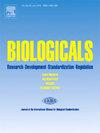A meta-analysis to re-evaluate the sensitivity and specificity of FMDV NSP ELISA tests
IF 1.5
4区 生物学
Q4 BIOCHEMICAL RESEARCH METHODS
引用次数: 0
Abstract
Foot-and-mouth disease (FMD) serosurveillance is used as one of the disease control instruments. For this goal, it is necessary to differentiate infected animals from the vaccinated ones using non-structural protein (NSP) enzyme-linked immunoassays (ELISA). Various NSP ELISA have been developed. However, their sensitivity and specificity have shown variable results. Therefore, a meta-analysis was conducted to re-evaluate the sensitivity and specificity of these ELISAs. Experimental data were analyzed using R version 4.2.1, employing the rma.mv function in {metafor} package, and the impute covariance_matrix function from the {clubSandwich} package. Commercial kits, the highest sensitivity (0.82, 0.83) and specificity (0.97) were observed in Kit 1 and 3 groups. Differences in performance measures due to animal profiles were not statistically justified. In-house kits, performance measures varied by animal species and NSP protein. Specifically, sensitivity and specificity were lower in pigs (0.62 and 0.81) compared to cattle (0.93 and 0.97) and sheep (0.94 and 0.98) with 3ABC protein. No significant differences were found between sheep and cattle. Additionally, assays using protein 2C showed significantly lower sensitivity and specificity compared to those using protein 3ABC. The highest diagnostic measures were observed in cattle and sheep tested with the 3AB protein, followed by 3B and 3ABC proteins.
重新评价FMDV NSP ELISA检测的敏感性和特异性的荟萃分析
口蹄疫(FMD)血清监测是疾病控制手段之一。为此,有必要使用非结构蛋白(NSP)酶联免疫分析法(ELISA)将感染动物与接种者区分开来。目前已开发了多种NSP酶联免疫吸附试验。然而,它们的敏感性和特异性显示出不同的结果。因此,我们进行了一项荟萃分析来重新评估这些elisa的敏感性和特异性。实验数据采用R 4.2.1版本,采用rma进行分析。{metafor}包中的mv函数,以及{clubSandwich}包中的impute covariance_matrix函数。商用试剂盒试剂盒1、3组灵敏度最高(0.82、0.83),特异性最高(0.97)。由于动物特征导致的性能测量差异没有统计学上的合理性。内部试剂盒,性能指标因动物种类和NSP蛋白而异。具体来说,猪对3ABC蛋白的敏感性和特异性分别为0.62和0.81,低于牛(0.93和0.97)和羊(0.94和0.98)。绵羊和牛之间没有发现显著差异。此外,与使用蛋白3ABC相比,使用蛋白2C检测的灵敏度和特异性明显较低。用3AB蛋白检测的牛和羊的诊断指标最高,其次是3B和3ABC蛋白。
本文章由计算机程序翻译,如有差异,请以英文原文为准。
求助全文
约1分钟内获得全文
求助全文
来源期刊

Biologicals
生物-生化研究方法
CiteScore
3.70
自引率
0.00%
发文量
39
审稿时长
48 days
期刊介绍:
Biologicals provides a modern and multidisciplinary international forum for news, debate, and original research on all aspects of biologicals used in human and veterinary medicine. The journal publishes original papers, reviews, and letters relevant to the development, production, quality control, and standardization of biological derived from both novel and established biotechnologies. Special issues are produced to reflect topics of particular international interest and concern.Three types of papers are welcome: original research reports, short papers, and review articles. The journal will also publish comments and letters to the editor, book reviews, meeting reports and information on regulatory issues.
 求助内容:
求助内容: 应助结果提醒方式:
应助结果提醒方式:


